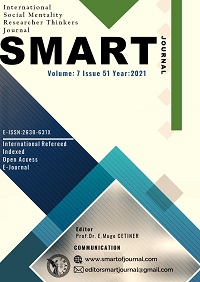Author :
Abstract
Osmanlı Haremi’nde hizmetçi ve eş konumundaki kadınlar yaşadıklarını sözlü ya da yazılı tarihe bırakmadıkları için Haremi anlatan eserlerin bir kısmı Avrupalı gezginler, büyükelçiler ve sarayda padişaha hizmet eden esirlerin gerçek ile kurgu arasında çeşitli tür bilgiler vermelerini sağlamıştır. On dokuzuncu yüzyılda gerçek ile kurgu arasındaki nesnellik sorunu derinleşmiştir. Böylece Hareme ilişkin bilgiler dünya görüşünden bağımsız değildir. Harem, bir görüşe göre Osmanlıyı çöküşe götüren en önemli etkenlerden biridir. Kimine göre sefahat ve entrika yuvası, kimine göre Osmanlı’nın çöküşüne sebep olmak bir yana ayakta kalmasının sebeplerinden biri, kimine göre ise padişahların mazbut aile yaşamını yansıtan evleridir. Bunlardan hangi görüşün Haremi doğru yansıttığı sorgulanırsa, hem “hepsi” hem de “hiçbiri”dir. Harem’de kadınlar, müellifler tarafından iki ayrı dünya görüşünde yan yana gelirken, kesin çözüme ulaşmadan ve yüzeysel uzlaşmayı geçmeyen eşiktedir. İki ayrı dünya görüşüne dayalı bu sosyal tabakanın bir yanında modernciler, diğer yanında İslâmcılar olsa da, modernleşme ve İslâmcılık hiçbir kontrol ve hesaplaşmadan geçmeden birbirine yabancı iki düşünce ve iki dünya görüşü olarak kalmaya devam etmektedir..
Keywords
Abstract
Women who are servant and wife in the Ottoman Harems have not left their experiences in oral or written history. Some of the works deciphering the Harem have provided information of various kinds between the fact and fiction of European travelers, ambassadors and prisoners serving the sultan in the palace. Similarly, in the nineteenth century, Western Orientalists' own fiction and fantasies created the problem of objectivity regarding the Harem. All this indicates that the information about the Harem is formed within the framework of a certain worldview. According to one opinion, one of the most important factors that led the Ottoman Empire to collapse, according to some it is a hotbed of debauchery and intrigue, according to others it is one of the reasons why the Ottoman Empire survived, aside from causing its collapse, and according to others it is their home where the sultans lead a mazbut family life. If it is questioned which of these views reflects the Harem correctly, it is both “all” and “none”. In the Harem, women stand side by side in two separate worldviews of objectivity and subjectivity, both by domestic and foreign opponents, while waiting at a threshold that does not reach a final solution and does not exceed superficial compromise. Moreover, although there are modernists on one side of a social stratum based on two separate worldviews, and Islamists on the other, modernization and Islamism are in the waiting ranks as two thoughts and two world views that are alien to each other without passing through any control and reckoning.
Keywords
- Akşit, İlhan, Osmanlı’nın Gizemi Harem, Akşit Yayınları, İstanbul, 2000.Akyıldız, Ali, Saray, Harem ve Mahrem, Timaş Yayınları, İstanbul, 2019.
- Arsal, Oğur, Modern Osmanlı Resminin Sosyolojisi (1839-1924), 1. Baskı, çev. Tuncay Birkan, Yapı Kredi Yayınları, İstanbul, 2000.
- Atçıl, Abdurrahman, “Osmanlı Haremi’ne Dört Farklı Bakış”, DİVÂN İlmî Araştırmalar, 15(2), 247-258, 2003.
- Baldil, Beliz, “Mekânsal Ritüeller, İktidar İlişkileri”, İstanbul Üniversitesi Sosyal Bilimler Enstitüsü Kadın Çalışmaları Anabilim Dalı, Yüksek Linsans Tezi, İstanbul, 2009.
- Baudrillard, Jean, Simülakrlar ve Simülasyon, 6. Baskı, çev. Oğuz Adanır, DoğuBatı Yayınları, Ankara, 2011.
- Bauman, Zygmunt, Özgürlük, 1. Baskı, çev. Kübra Eren, Ayrıntı Yayınları, İstanbul, 2015.
- Burbank, Jane; Cooper, Frederick, İmparatorluklar Tarihi, Farklılıkların Yönetimi ve Egemenlik, çev. Ahmet Aybars Çağlayan, İnkılâp Yayınları, İstanbul, 2011.
- Campenella, Tommaso, Güneş Ülkesi, çev. Vedat Günyol-Haydar Kazgan, Sosyal Yayınları, İstanbul, 1985. Dânişmend, İsmâil Hâmî, İzahlı Osmanlı Tarihi Kronolojisi, cilt 2, Türkiye Yayınevi, İstanbul, 1971.
- Demircan, Adnan, “Tarih Üzerine Bazı Düşünceler”, İnanç, Kültür ve Mitoloji Araştırmaları Dergisi, 4(3), 69-89, 2007.
- Durgun, Serpil; Aşkın, Zehragül, “Edward Hallet Carr’ın Perspektifinden Tarihte Nedensellik: Hegel’inKötülüğü ve Kleopatra’nın Burnu”, Beytulhikme An International Journal of Philosophy, 5(1), 59-79, 2015.Eversley, Lord; Chirol, Sir Valantine, Türk İmparatorluğu (1288-1924), 1. Baskı, çev. Sedat Demir-Billur Manav Arslan, Dün Bugün Yarın Yayınları. İstanbul, 2013.
- Gülaçtı, İsmail Hakkı, “Oryantalizm’in Ellerindeki Fotoğraf: Osmanlı Devleti’nin 19. Yüzyıl Fotoğrafçılığında ‘Öteki’nin Mikrokozmosu Olarak Yansıması”, Art Sanat, 81-120, 2018.
- Haykır, Yavuz; Haykır, Handan, “Tarihsel Süreç İçerisinde Türk Aile Yapısına Bir Bakış”, Türk Dünyası Araştırmaları, 117(230), 87-106, 2017.
- İnalcık, Halil, Has-Bağçede ‘Ayş u Tarab-Nedîmler, Şâîrler, Mutrîbler, Türkiye İş Bankası Kültür Yayınları, İstanbul, 2015.
- Kantemir, Dimitri, Osmanlı İmparatorluğu’nun Yükseliş ve Çöküş Tarihi I, 1. Baskı, çev. Özdemir Çobanoğlu, Kültür Bakanlığı Yayınları, Ankara, 1979.
- Kocaaslan, Murat, “Osmanlı Sarayı’nın Mahremi: Topkapı Sarayı Haremi’nin Sınır ve Yasakları”, Hacettepe Üniversitesi Edebiyat Fakültesi Dergisi, 28(2), 95-121, 2011.
- Kocaaslan, Murat, “Osmanlı Haremi’nde Geleneksel Seyirlik Oyunları”, Milli Folklor, 31(124), 136-146, Kütükoğlu, S. Mübahat, Osmanlı Belgelerinin Dili (Diplomatik), Kubbealtı Neşriyat, İstanbul, 1994.
- Menteş, Fatma, “Osmanlı İmparatorluğunda Yenileşme Sürecinde Harem”, Ege Üniversitesi Sosyal Bilimler Enstitüsü Tarih Anabilim Dalı, Yüksek Lisans Tezi, İzmir, 2006.
- Özdemir, Hayrunnisa, “Hadım Etme ve Hekimin Sır Saklama Yükümlülüğü”, Ankara Hacı Bayram Veli Üniversitesi Hukuk Fakültesi Dergisi, 14(1), 125-164, 2010.
- Penzer, N. M. Harem, 1. Baskı, çev. Doğan Şahin, Say Yayınları, İstanbul, 2000.
- Sancar, Aslı, Osmanlı Kadını: Efsane ve Gerçek, (ed.) Hakan Yeşil Ova-Hasan Hayri Demirel, Kaynak Yayınları, İzmir, 2009.
- Sencer, Muzaffer, “Tanzimata Kadar Osmanlı Yönetim Sistemi”, Amme İdaresi Dergisi, 17(2), 21-44, 1984. Serling, Rod, “The monsters are due on maple street”, The Twilight Zone, Episode 22, 1962.
- Taş, Mehmet, “Saray Kadınlarının Osmanlı Devlet Yönetiminde Çeşitli İşlevleri”, Turkish Studies, 9(10), 1294-1312, 2014.
- Tokmakçıoğlu, Erdoğan, Osmanlı Kadın Akımları, Geçit Yayınları, İstanbul, 1991.
- Turak, Mert, “Turan Oflazoğlu’nun “IV. Murad” Adlı Oyununda Tarihsel Kişilerin Trajik Karakterlere Dönüşümü”, Bahçeşehir Üniversitesi Yüksek Lisans Tezi, İstanbul, 2010.
- Uluçay, M. Çağatay, Harem II, 3. Baskı, Türk Tarih Kurumu Yayınları, Ankara, 1992.
- Uluçay, M. Çağatay, Osmanlı Sultanlarına Aşk Mektupları, 2. Baskı, Ufuk Kitapları, İstanbul, 2001.Ülken, Hilmi Ziya, Türkiye’de Çağdaş Düşünce Tarihi, 3. Baskı, Ülken Yayınları, İstanbul, 1992.
- Withers, Robert, Büyük Efendi’nin Sarayı, çev. Cahit Kayra, Pera Turizm ve Ticaret AŞ,İstanbul, 1996.
- Zeydân, Corcî, İslâm Uygarlıkları Tarihi II, 2. Baskı, çev. Nejdet Gök, İletişim Yayınları, İstanbul, 2015.
